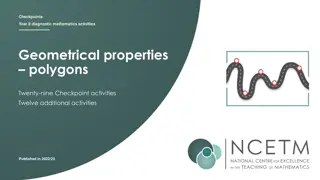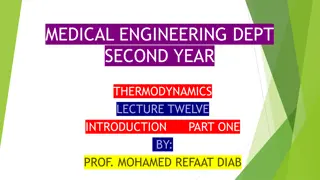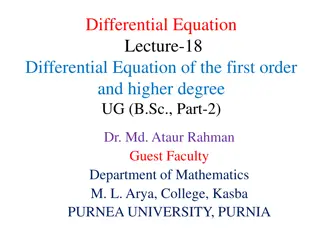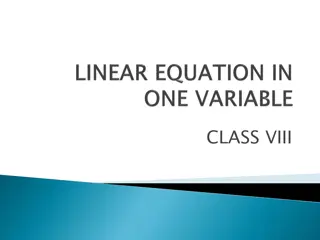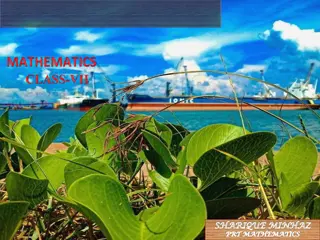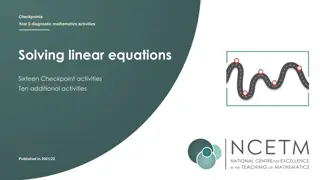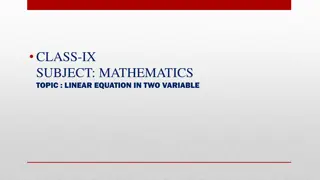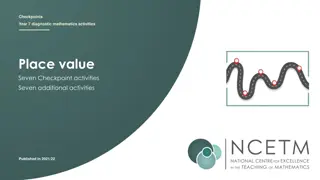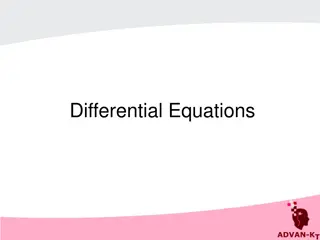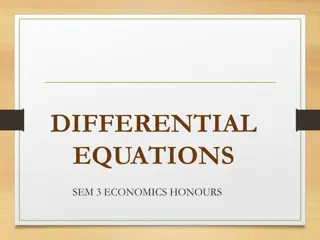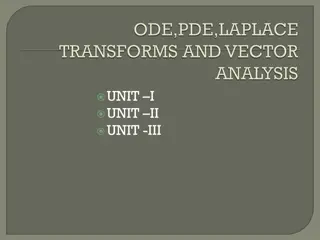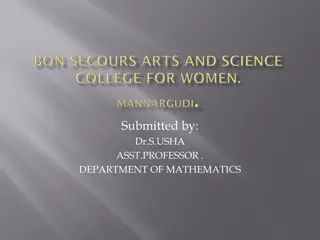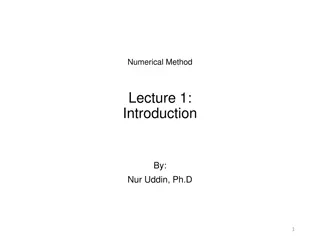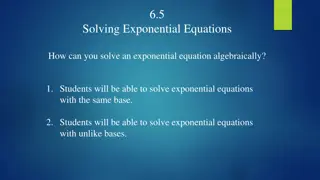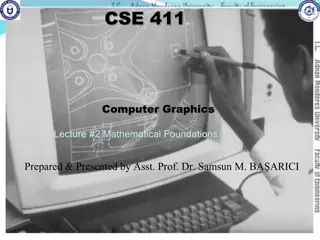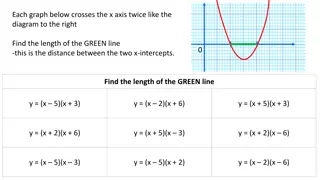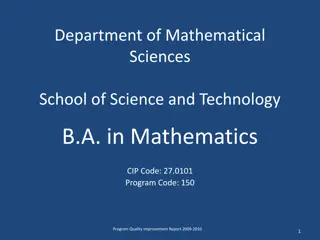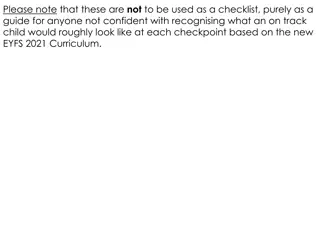Mathematical Checkpoints and Equations Activities for Year 7 Students
Engage Year 7 students in a series of 16 checkpoint activities and 12 additional activities focused on expressions, equations, and mathematical concepts. Explore topics like checks and balances, shape balance, equations from bar models, number line concepts, and more to enhance mathematical understanding and problem-solving skills.
Download Presentation

Please find below an Image/Link to download the presentation.
The content on the website is provided AS IS for your information and personal use only. It may not be sold, licensed, or shared on other websites without obtaining consent from the author.If you encounter any issues during the download, it is possible that the publisher has removed the file from their server.
You are allowed to download the files provided on this website for personal or commercial use, subject to the condition that they are used lawfully. All files are the property of their respective owners.
The content on the website is provided AS IS for your information and personal use only. It may not be sold, licensed, or shared on other websites without obtaining consent from the author.
E N D
Presentation Transcript
Checkpoints Year 7 diagnostic mathematics activities Expressions and equations Sixteen Checkpoint activities Twelve additional activities Published in 2021/22
Checkpoints 18 Checkpoint 1: Checks and balances 2: Shape balance 3: Equations from bar models 4: Colouring the number line 5: Number line equations 6: Stick differences 7: Mystery bars 8: Equations for heights Underpins Code 1.4.1* Generalise relationships *This three-digit code refers to the statement of knowledge, skills and understanding in the NCETM s Sample Key Stage 3 Curriculum Framework (see notes below for more information).
Checkpoints 916 Checkpoint 9: Final scores 10: Roast dinner 11: x + y = 20 12: Same and different 13: Numbers box 14: Triangle and rectangle values 15: Arithmequick 16: Square numbers Underpins Code Unknowns and variables 1.4.1* 1.4.2 and 1.4.3 Unitising and the distributive law *This three-digit code refers to the statement of knowledge, skills and understanding in the NCETM s Sample Key Stage 3 Curriculum Framework (see notes below for more information).
Generalise relationships Checkpoints 1 8
Checkpoint 1: Checks and balances These scales are balanced. a) What do you know about the plain box? Using the original picture as your starting point, what would happen to the scales if: b) The plain box was replaced by a checked box? c) A plain box was added to the left-hand side? How could you keep the scales balanced if: d) A plain box was added to the right-hand side? e) Two of the boxes on the left-hand side were replaced by plain boxes? Five more boxes are added. Is it possible for the scales still to be balanced?
Checkpoint 2: Shape balance a) These scales are balanced. What might be the mass of the triangle and the circle? Is there more than one answer? Why or why not? b) The scales are still balanced. What might be the mass of the triangle and the circle? Is there more than one answer? Why or why not? c) The scales are no longer balanced. What could be done to balance them? Is there more than one answer? Why or why not? How would your answer to part c change if the mass on the right-hand side of the scales was 19? How about 14? Or 25? Or 30?
Checkpoint 3: Equations from bar models Tilly looks at the bar model and writes c a = 10. Alice looks at the bar model and writes a different equation. What might Alice have written? c a 10 The bar model changes. Jas writes c + 6 a = 16. Beth looks at the bar model and writes a different equation. What might Beth have written? c 6 6 a 10 A different bar model shows 10 p = r. Draw the bar model. What other equations can you write with p and r?
Checkpoint 4: Colouring the number line a) Write a calculation to work out the length of the red section. b) Write a calculation to work out the length of the blue section. Sharon colours a section of the number line. 132 147 136 Sharon colours a different section of the number line. She covers the numbers with sticky notes c) Write a calculation to work out the length of the new red section. d) Write a calculation to work out the length of the new blue section. 7 14 12 Sharon writes purple = yellow red. Write an expression for each of the other sticky notes. Is there more than one way to do this?
Checkpoint 5: Number line equations Cerys and Dan each mark a number on a number line. Dan s number is larger than Cerys s. c) Cerys adds 1 to her number. Dan adds 2 to his number. What happens to y? d) Cerys subtracts 10 from her number. Dan adds 10 to his number. What happens to y? b) Cerys and Dan each add 1 to their numbers. What happens to y? a) What does the formula n m = y represent? Cerys and Dan both double their numbers. Does the value of y change? If so, by how much?
Checkpoint 6: Stick differences James has two sticks. When he balances the sticks on top of each other, the total height is 150 cm. When he stands them next to each other, the purple stick is 10 cm longer than the green stick. How long is each stick? Create your own stick problem. What information must you give to make sure it is solvable?
Checkpoint 7: Mystery bars The top blue bar and the bottom orange bar each represent a different number. The top blue bar number is three times the bottom orange bar number. The difference between the two numbers is 8. Will the two bulleted statements still be true if: a) I add 1 to both of the original numbers? b) I double both of the original numbers? c) I halve both of the original numbers? What could the numbers be? Is there more than one possible answer?
Checkpoint 8: Equations for heights Look at the picture of Elinor and Ben. a) What do you know about their heights? What do you not know? Elinor writes an equation for their heights: m + 15 = n. b) Which letter represents Elinor s height? Which represents Ben s height? c) Ben stands on a step which is 10 cm high. How does this change the equation? d) How would your answer to question b change if Elinor had stood on the step instead? Oscar is 7 cm shorter than Elinor. Write an equation connecting Elinor and Oscar s height Write an equation connecting Ben and Oscar s height
Unknowns and variables Checkpoints 9 13
Checkpoint 9: Final scores Yusra Felix Yusra and Felix are playing a game. They each collect two different types of tokens. These are their final scores. a) Who do you think won the game? Why? b) If Yusra won the game, what would this tell you about the value of the circle compared to the pentagon? c) If the circle is worth 5, what might the pentagon be worth? d) If the pentagon is worth 5, what might the circle be worth? e) Could you write an expression to describe each person s final score? Suggest some other values for the pentagon and circle. What is the smallest and largest each could be?
Checkpoint 10: Roast dinner Sam is making a roast dinner. He needs to know how long to cook the lamb for. His recipe book gives two options for the cooking times, in minutes: Medium: Well done: 40 weight (in kg) + 20 50 weight (in kg) + 20 a) b) What s the same and what s different about the two recipes? How long will he need to cook the lamb to medium if it weighs: 1 kg 2 kg 1.5 kg. How much longer would he need each time if he wanted the lamb to be well done? Sam actually cooked the lamb for 2 hours 20 minutes. What weight might it have been? c)
Checkpoint 11: x + y = 20 x + y = 20 Is it possible to find values for x and y if: a) They are both odd b) They are both even c) Only one is even d) They are both prime e) They are both multiples of 3 f) They are both multiples of 4 g) One is three times the other h) One is half the other? Some of the conditions above were impossible. Which ones? How could you change the question to make them possible?
Checkpoint 12: Same and different a + 3 = 10 a + 3 > 10 a + b = 10 a + b > 10 What is the same? What is different? How many different values can you think of for a and b each time? How have these changed? How many different values can you think of for a each time? Is this more or less than before? Why? Create your own equations and inequalities. Can you create an equation with just one value for a or b? Can you create an equation with more than one value?
Checkpoint 13: Numbers box 9 12 0 g + h 2 4 1 3 15 a) Choose a number from the box for g. Choose a different number from the box for h. What is the greatest total you can create? b) How would your answers be different if the expression was 2g + h? Kazia used numbers from the box for 2g + h. Her total was 9. What numbers might she have used for g and h?
Unitising and the distributive law Checkpoints 14 16
Checkpoint 14: Triangle and rectangle values 3 + 6 + 7 + 9 What is the value of the expression if: a) b) c) d) e) f) = 3 and = 0 = 0 and = 2 = 3 and = 2 = 2 and = 3 = 6 and = 4 = 0.8 and = 0.8 Was there an easier way to find your answers? Write a different expression using and that would have the same value.
Checkpoint 15: Arithmequick Find a quick way to write the answer to: a) 5 37 + 3 37 + 2 37 b) 7 763254 + 3 763254 c) 7 7632.54 + 3 7632.54 d) 17 837468 7 837468 + 2 e) 3756 + 3756 + 3756 + 3756 + 3756 + 3756 + 3756 + 3756 + 3756 + 3756 + 9 f) 49 8 + 51 3 + 51 7 + 2 49 Explain why you can t find a quick way to write the answer to: g) 7 23764 + 3 56982 Find some possible values to make this calculation correct: ___ 28 + ___ 28 ___ 28 = 280
Checkpoint 16: Square numbers Three tiles are arranged to make a square Alison, Bola and Celia want to find the area of the square. Alison did (4 + 3) 7. Bola did 4 2 + 3 7 + 4 5. 5 7 Celia did 4 7 + 3 7. Each person s method is correct. Describe how Alison, Bola and Celia each worked out the problem. 4 Umar replaces the lengths on the diagram with numbers that increase the area of the whole square to 81. What numbers might he have used?
Additional activities Activities A L
Activity A: Checks and balances 2 Mr Griffith shows the class these balanced scales: John writes this equation: 5a = 2a + b a) What is the same/different about the scales and John s equation? b) What can you work out? Do you find the scales or the equation easier for this? c) 5a = 15. What does this tell you about the value of a and b? John changes the + sign to a sign on the right-hand side of his equation. How does the left-hand side of his equation need to change? Is there more than one way to do this?
Activity B: Checks and balances 3 Jenny writes this equation: 5a = 2a + b a) What do you know about b? Using the original equation as your starting point each time, how could you keep the equation balanced if: b) The b was replaced by another a? c) A b was added to the left-hand side? d) Another b was added to the right-hand side? e) 2a was replaced by 2b on the left-hand side? Jenny wants to add five more a terms and two more b terms to the equation. Can she do this and keep the equation balanced? Why or why not?
Activity C: Equals sign 12 cm Billy: 3 cm 3 x 12 = 36 2 = 18 Billy and Maya both use the formula base height 2 to work out the area of this triangle to be 18 cm2. a) What is the same and what is different about their workings? b) Who has used the = sign correctly? Maya: (3 x 12) 2 = 36 2 = 18 How many different ways can you write the workings for the area of a triangle with base 15 cm and height 4 cm?
Activity D: Number line equations 2 Sifan and Laura each think of a number. Sifan snumber is larger than Laura s. Both numbers are marked on a number line. d) What calculations can you write using Laura and Sifan s numbers? a) Which letter represents Sifan s number? b) Which letter represents Laura s number? c) How much more than Laura s number is Sifan s number? Eden thinks of a number. Eden s number is fsmaller than Laura s number. Mark a possible position for Eden s number on the number line. How many calculations can you write using Eden s number?
Activity E: Introduction to equations from bar models Daisy looks at the bar model and says, Blue minus red is equal to yellow. Stan looks at the bar model and says a different equation. a) What might Stan have said? The bar model changes a little. Daisy writes c + a = 10. Stan looks at the bar model and writes a different equation. b) What might Stan have written? 10 a c A different bar model shows 10 + b = e. Draw the bar model. What other equations can you write with b and e?
Activity F: Stick difference methods James has two sticks. a) b) How do Montel and Jake s workings compare to your thinking? What should they do next? When he balances the sticks on top of each other, the total height is 150 cm. Montel Jake When he stands them next to each other, the purple is 10 cm taller than the green. P = G + 10 P + G = 150 G + 10 + G = 150 G + G = 140 10 The small bit of purple is worth 10, so the two greens are worth 140. 150 How long is each stick? Create your own stick problem. What information must you give to make sure it is solvable?
Activity G: Same and different 2 2a + b = 10 2a + b > 10 2a + 3 = 10 2a + 3 > 10 What is the same? What is different? How many different values can you think of for a and b each time? How have these changed? How many different values can you think of for a each time? Is this more or less than before? Why? Create your own equations and inequalities. Can you create an equation with just one value for a or b? Can you create an equation with more than one value?
Activity H: Moving twos Look at these three cards: a2 2a a + 2 a) How would you read each of the cards out loud? b) Find a value for a that makes the red (left-hand) card have the greatest value. c) Find a value for a that makes the blue (right-hand) card have the greatest value. d) Find a value for a that makes the green (middle) card have the lowest value. Find a value that makes all the cards have an equal value.
Activity I: Thinking of a number Zak and Pete are each thinking of a positive number. Their numbers sum to 50. What will happen to the total if Zak: a) Adds 1 to his number? b) Subtracts 5 from his number? c) Doubles his number? d) Subtracts Pete s number from his number? What will happen to the total if they both: e) Add 1 to their numbers? f) Subtract 5 from their numbers? g) Double their numbers? h) Subtract the other person s number from their own? For the questions in the left-hand blue box, what would Pete have to do to his number to ensure that the total of their numbers stayed as 50?
Activity J: Tile animals Bruno is making pictures out of blue and red tiles. a) Bruno says the total number of holes in each of his pictures is 5 the number of red tiles + 2 the number of blue tiles. He writes H = 5r + 2b. Do you agree with Bruno s rule? 1 3 2 b) c) Write the value of H for each of the pictures Bruno makes a picture with 30 holes. Write three possible values for r and b for his new picture. Bruno makes another picture. He writes H = 320. He then changes his picture and writes H = 330. What changes might he have made? What if he d written H = 340?
Activity K: Triangle and rectangle values 6 + 5 + 4 What is the value of the expression if: a) b) c) d) e) f) = 3 and = 0 = 0 and = 2 = 1 and = 2 = 2 and = 3 = 4 and = 8 = 0.5 and = 0.5 Was there an easier way to find your answers? Write a different expression using and that would have the same value.
Activity L: Square letters Three tiles are arranged to make a square. Which lengths or areas are given by: 1) a + b 2) b + c 3) b c 4) a d 5) a d + b c 6) c d d c a b How many different ways can you write the total perimeter of the square?
Well done: Well done: Medium: Medium: 40 ___ + 20 = 50 ___ + 20 = 40 ___ + 20 = 50 ___ + 20 = 40 ___ + 20 = 50 ___ + 20 = 40 ___ + 20 = 50 ___ + 20 = 40 ___ + 20 = 50 ___ + 20 = 40 ___ + 20 = 50 ___ + 20 = 40 ___ + 20 = 50 ___ + 20 = 40 ___ + 20 = 50 ___ + 20 = 40 ___ + 20 = 50 ___ + 20 = 40 ___ + 20 = 50 ___ + 20 = 40 ___ + 20 = 50 ___ + 20 = 40 ___ + 20 = 50 ___ + 20 = 40 ___ + 20 = 50 ___ + 20 = 40 ___ + 20 = 50 ___ + 20 = 40 ___ + 20 = 50 ___ + 20 = 40 ___ + 20 = 50 ___ + 20 =
3 + 6 + 7 + 9 3 + 6 + 7 + 9 3 + 6 + 7 + 9 3 + 6 + 7 + 9 3 + 6 + 7 + 9 3 + 6 + 7 + 9 3 + 6 + 7 + 9
Yellow Yellow Yellow 5 5 5 Blue Blue Blue 7 7 7 Red Red Red 4 4 4 Yellow Yellow Yellow Blue Blue Blue Red Red Red
Extracts from mathematics past papers from Standards & Testing Agency and other Public sector information licensed under the Open Government Licence v3.0.


